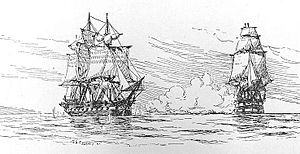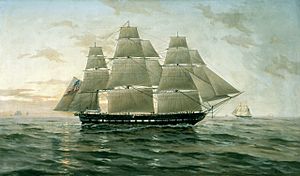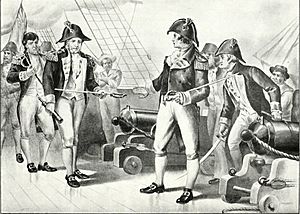Chesapeake–Leopard affair facts for kids
Quick facts for kids Chesapeake–Leopard affair |
|||||||
|---|---|---|---|---|---|---|---|
| Part of the events leading to the War of 1812 | |||||||
 HMS Leopard (right) fires upon USS Chesapeake |
|||||||
|
|||||||
| Belligerents | |||||||
| Commanders and leaders | |||||||
| Strength | |||||||
| 1 4th rate | 1 frigate | ||||||
| Casualties and losses | |||||||
| None |
|
||||||
The Chesapeake–Leopard affair was a serious naval event that happened on June 22, 1807. It took place off the coast of Norfolk, Virginia. A British warship, HMS Leopard, attacked an American warship, USS Chesapeake.
The British crew was looking for sailors who had left their ships without permission, called deserters. The Leopard chased, attacked, and then boarded the American ship. The Chesapeake was not ready for a fight. After a short battle where the Leopard fired many shots, the American commander, James Barron, gave up his ship. The Chesapeake had only fired one shot.
Four American crew members were taken from the ship. They were put on trial for desertion. One of them was later executed. The Chesapeake was allowed to go home. Commander James Barron was later put on trial by a military court and lost his command.
This event made many Americans very angry. People called for war with Great Britain. President Thomas Jefferson tried to use this anger to make the British government settle the issue. However, the British did not apologize. They even said they would continue to take sailors from American ships. Because of this, President Jefferson tried to use economic pressure instead, by stopping trade with other countries.
| Top - 0-9 A B C D E F G H I J K L M N O P Q R S T U V W X Y Z |
Why It Happened: The Background

In 1807, during a time of war in Europe, several British navy ships were near the American coast. They were blocking two French warships in Chesapeake Bay. Some British sailors had left their ships without permission. American officials in the area gave these sailors a safe place to stay.
One of these deserters was a man named Jenkin Ratford. He joined the crew of the American ship USS Chesapeake. British officers noticed Ratford because he would shout at them in the streets of Norfolk, Virginia.
Other deserters were also reported at the Norfolk Naval Shipyard. The British consul asked the American commander there, Stephen Decatur, to hand over three men. These men were said to have deserted from a British ship called HMS Melampus. The consul claimed these men had joined the U.S. Navy. The Chesapeake was getting ready for a trip to the Mediterranean Sea.
A British admiral, George Cranfield Berkeley, sent his flagship, the warship HMS Leopard. He gave the Leopard's captain written orders. These orders allowed him to board and search the American warship. He wanted to find any British deserters.
The Attack and Search
The Chesapeake was off the coast of Norfolk, Virginia. It was commanded by Commodore James Barron. The Leopard, led by Captain Salusbury Pryce Humphreys, met the Chesapeake and called out to it. Commander Barron was not worried. He allowed a British officer, Lieutenant John Meade, to come aboard. Meade showed Barron a search warrant. After talking, Meade went back to the Leopard.
Captain Humphreys then used a special horn to order the American ship to stop. When the Chesapeake did not obey, Humphreys fired a warning shot across its front. Immediately after, the Leopard fired all its guns at once, called a broadside, into the American ship. The Chesapeake was not ready for battle. Its guns were not loaded, and its decks were full of supplies for a long trip. It only managed to fire one shot back.
Humiliated, Commander Barron lowered his ship's flag, which meant he was surrendering. Three of the Chesapeake's crew members were killed. Eighteen were wounded, including Barron himself. However, Captain Humphreys did not accept the surrender right away. He sent a group of his men to board the Chesapeake to search for deserters.
Many British citizens had joined the Chesapeake as crew members. But Humphreys only took four British navy deserters. Their names were Daniel Martin, John Strachan, William Ware, and Jenkin Ratford. Only Ratford was born in Britain. The others were American residents, but they had served on British warships before. For example, Daniel Martin said he was born in Massachusetts.
The British ship Columbine brought the first news of the event to Halifax, Nova Scotia. The Leopard followed with the captured sailors for trial. Jenkin Ratford, the only British citizen, was sentenced to death. He was executed on August 31, 1807. The three American deserters were sentenced to 500 lashes each. However, these punishments were later canceled.
This violent event caused a huge protest from the U.S. government. The British government eventually offered to return the three American residents. They also offered to pay for the damage done to the Chesapeake. The British ship HMS Bream returned the last two American sailors to Boston. This happened one month after the War of 1812 began.
What Happened Next: The Aftermath
The incident made American public opinion very angry. Many felt that the country's honor had been disrespected. Americans from all political groups spoke about the need to protect national honor. They wanted to show that the United States was not a weak country. Many Americans demanded war because of the attack.
President Thomas Jefferson said that he had never seen the country so angry. He said it was even more anger than during the Battles of Lexington and Concord. James Monroe, who was a foreign minister, made demands to the British. He asked them to say they were wrong. He also asked for the four sailors to be returned. He wanted Admiral Berkeley to be removed from his post. He also demanded that British warships stay out of U.S. waters. Most importantly, he wanted them to stop taking sailors from American ships.
This event increased tensions between the two countries. While it might not have been the only reason, it was one of the key events that led to the War of 1812. President Jefferson tried diplomacy and economic pressure. He passed the Embargo Act of 1807, which stopped American ships from trading with other countries. This act did not work well.
The U.S. government became worried about not having enough war supplies. This led to a tax that helped companies making gunpowder. This helped the DuPont company grow.
The incident also had big effects on the U.S. Navy. People were shocked that the Chesapeake could not fight back. It surrendered so quickly. People questioned if the Navy could defend the country if there was a war with Great Britain. This was despite the expensive program to build new warships. A military court blamed Commander Barron. They suspended him from service for five years as punishment.
Years later, in 1820, Commodore Barron fought a duel with Commodore Stephen Decatur. Barron was wounded, and Decatur was killed. This duel was over comments Decatur had made about Barron's actions in 1807. Decatur had been part of the court-martial that found Barron guilty.
The Chesapeake itself was captured during the War of 1812. On June 1, 1813, a British ship, HMS Shannon, captured the Chesapeake. This happened in a single ship battle near Boston. The British Navy used the Chesapeake for a while. Then, they sold it in 1819. Parts of the Chesapeake's wood are now part of the Chesapeake Mill in England.
In Stories
The Chesapeake–Leopard affair is mentioned in some books. In the Aubrey–Maturin series by Patrick O'Brian, Captain Jack Aubrey commands the Leopard years after the incident. Even though it's peaceful, American sailors are still wary of his ship because of the past event. The later capture of the Chesapeake during the War of 1812 is also a big part of another book in the series.
The Chesapeake–Leopard affair is also mentioned in the Boston Jacky novel. This book is part of the Bloody Jack adventure series by L.A. Meyer.




